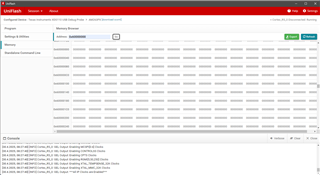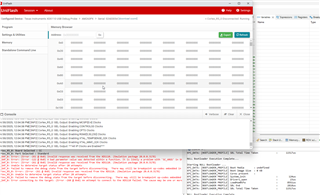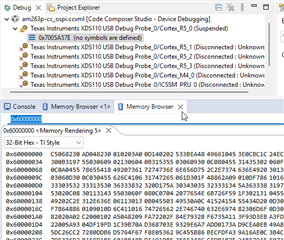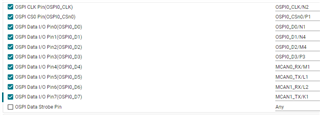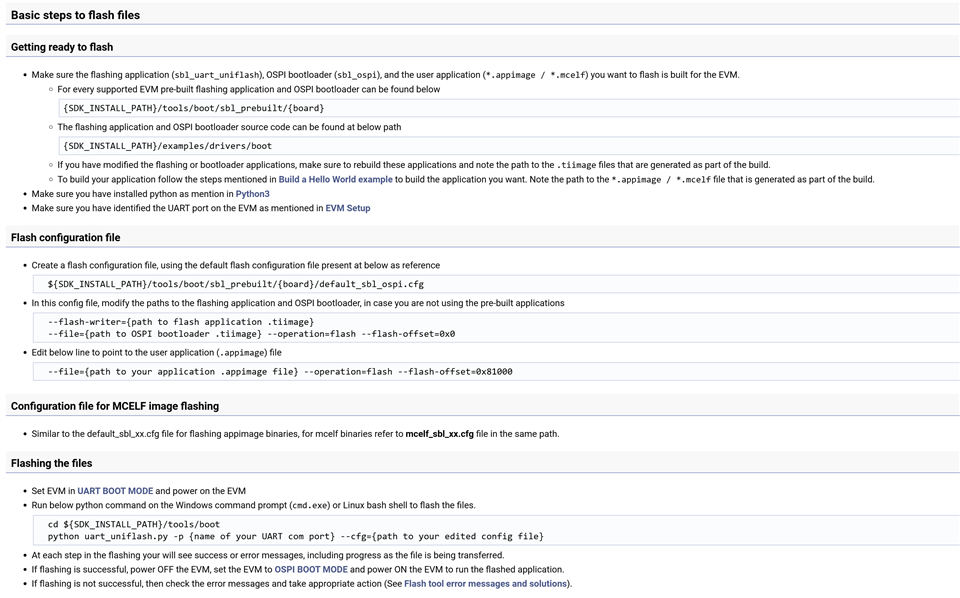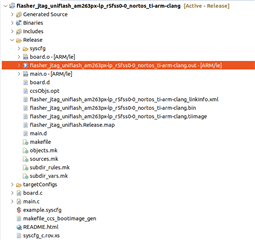Other Parts Discussed in Thread: UNIFLASH, SYSCONFIG
Tool/software:
Hey Experts,
ive a question regarding flashing my custom board.
As flash iam using the IS25LX064 (same as at eval boards just with 64mb ram instead of 256mb)
As SW i am using:
CCS 12.8.1.00005
SDK 10_00_00_35
Uniflash 8.8.1.4983
At first i read this guide: https://software-dl.ti.com/mcu-plus-sdk/esd/AM263PX/latest/exports/docs/api_guide_am263px/CUSTOM_FLASH_SUPPORT_GUIDE.html and run the ospi flash diagnostic example with the following output:
Cortex_R5_0] [OSPI Flash Diagnostic Test] Starting ...
[OSPI Flash Diagnostic Test] Flash Manufacturer ID : 0x9D
[OSPI Flash Diagnostic Test] Flash Device ID : 0x5A17
[OSPI Flash Diagnostic Test] Executing Flash Erase on first block...
[OSPI Flash Diagnostic Test] Done !!!
[OSPI Flash Diagnostic Test] Performing Write-Read Test...
[OSPI Flash Diagnostic Test] Write-Read Test Passed!
[QSPI Flash Diagnostic Test] SFDP Information :
================================================
SFDP
================================================
SFDP Major Revision : 0x1
SFDP Minor Revision : 0x9
Number of Parameter Headers in this Table : 3
Types of Additional Parameter Tables in this flash
---------------------------------------------------
4 BYTE ADDRESSING MODE INSTRUCTIONS TABLE
NOR SPI PROFILE TABLE
JSON Data for the flash :
{
"flashSize": 8388608,
"flashPageSize": 256,
"flashManfId": "0x9D",
"flashDeviceId": "0x5A17",
"flashBlockSize": 131072,
"flashSectorSize": 4096,
"cmdBlockErase3B": "0xD8",
"cmdBlockErase4B": "0xDC",
"cmdSectorErase3B": "0x20",
"cmdSectorErase4B": "0x21",
"protos": {
"p111": {
"isDtr": false,
"cmdRd": "0x03",
"cmdWr": "0x02",
"modeClksCmd": 0,
"modeClksRd": 0,
"dummyClksCmd": 0,
"dummyClksRd": 0,
"enableType": "0",
"enableSeq": "0x00",
"dummyCfg": null,
"protoCfg": null,
"strDtrCfg": null
},
"p112": null,
"p114": null,
"p118": {
"isDtr": false,
"cmdRd": "0x7C",
"cmdWr": "0x84",
"modeClksCmd": 0,
"modeClksRd": 1,
"dummyClksCmd": 0,
"dummyClksRd": 7,
"enableType": "0",
"enableSeq": "0x00",
"dummyCfg": null,
"protoCfg": null,
"strDtrCfg": null
},
"p444s": null,
"p444d": null,
"p888s": null,
"p888d": {
"isDtr": false,
"cmdRd": "0x0B",
"cmdWr": "0x12",
"modeClksCmd": 0,
"modeClksRd": 0,
"dummyClksCmd": 8,
"dummyClksRd": 32,
"enableType": "0",
"enableSeq": "0x00",
"dummyCfg": {
"isAddrReg": false,
"cmdRegRd":"0x00",
"cmdRegWr":"0x00",
"cfgReg":"0x00000000",
"shift":0,
"mask":"0x00",
"bitP":31
},
"protoCfg": {
"isAddrReg": false,
"cmdRegRd": "0x00",
"cmdRegWr": "0x00",
"cfgReg": "0x00000000",
"shift": 0,
"mask": "0x00",
"bitP": 0
},
"strDtrCfg": {
"isAddrReg": false,
"cmdRegRd": "0x00",
"cmdRegWr": "0x00",
"cfgReg": "0x00000000",
"shift": 0,
"mask": "0x00",
"bitP": 0
}
},
"pCustom": {
"fxn": null
}
},
"addrByteSupport": "1",
"fourByteAddrEnSeq": "0x22",
"cmdExtType": "REPEAT",
"resetType": "0x30",
"deviceBusyType": "0",
"cmdWren": "0x06",
"cmdRdsr": "0x05",
"srWip": 0,
"srWel": 0,
"cmdChipErase": "0xC7",
"rdIdSettings": {
"cmd": "0x9F",
"numBytes": 5,
"dummy4": 0,
"dummy8": 0
},
"xspiWipRdCmd": "0x00",
"xspiWipReg": "0x00000000",
"xspiWipBit": 0,
"flashDeviceBusyTimeout": 20000000,
"flashPageProgTimeout": 120
}
All tests have passed!!
That done i conclude my flash is connected correctly?
I only wonder why this differs to the jason data provided in the sdk(see attached file).
After that i took the flasher_jtag_uniflash_am263px-lp example, adapted the pinning in sysconfig and changed the flash settings ( just ID and size, if i changed other parameters it wont function anymore)
Then i took the Uniflashtool, chose the cosum flasher with the correct path to my adapted lasher_jtag_uniflash_am263px-lp example and flashed a adapted sbl_ospi and my application:
Here iam not quite sure what defines at which adress the external flash is located. I just took the adresses i used when i tested it at the am263p-cc eval board.
When i load the files uniflash says flashing was okay: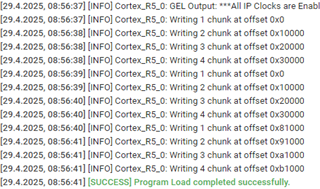
but when i try to read the memory at adress 0x60000000 there are just zeros. So nothing was written there.
Any ideas of what iam doing wrong?
Best regards
Marcel


